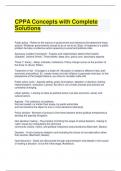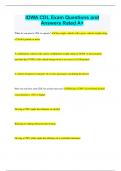Exam (elaborations)
Marketing trial exam 2020 - Oefententamen 2020
- Course
- Institution
- Book
This trial exam consist of 32 MC questions equally spread over all the 10 lectures and 24 chapter of the book you needed to learn. Based on the book, and on complete and good information. It can provide you with a fast check if you learned enough for the exam. All the answers and the explanation ...
[Show more]













